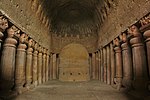Sanjay Gandhi National Park
1969 establishments in MaharashtraBorivaliEngvarB from September 2013IUCN Category IIMalabar Coast moist forests ... and 4 more
Mumbai Suburban districtNational parks in MaharashtraParks in MumbaiProtected areas established in 1969

Sanjay Gandhi National Park is a 87 km2 (34 sq mi) protected area in Mumbai, Maharashtra State in India. It was established in 1969 with headquarters at Borivali.The 2400-year-old Kanheri caves sculpted by monks out of the rocky cliffs, lie within the park. The rich flora and fauna of Sanjay Gandhi National Park attract more than 2 million visitors every year.
Excerpt from the Wikipedia article Sanjay Gandhi National Park (License: CC BY-SA 3.0, Authors, Images).Sanjay Gandhi National Park
Mumbai Metropolitan Region
Geographical coordinates (GPS) Address Nearby Places Show on map
Geographical coordinates (GPS)
| Latitude | Longitude |
|---|---|
| N 19.25 ° | E 72.916666666667 ° |
Address
Yeoor
400610 Mumbai Metropolitan Region, Yeoor
Maharashtra, India
Open on Google Maps





